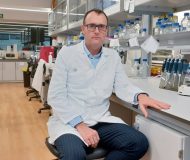

An international study in which researchers from the Research Institute of the Hospital de la Santa Creu i Sant Pau – IIB Sant Pau and the Universitat Autònoma de Barcelona (UAB) have participated has identified the mechanism by which patients with Fanconi anemia develop head and neck tumors and have been able to verify that it is the same mechanism that explains why smoking and drinking increase the risk of this type of cancer in the general population.
The results, published by the prestigious journal Nature, show that the deficiency in the cells’ natural process to repair the damage produced by chemicals that damage DNA, called aldehydes, is responsible for the risk of developing carcinoma of head and neck squamous cells.
Dr. Jordi Surrallés, head of DNA Repair Syndromes and Predisposition to Cancer research group and director of the Research Institute of the Hospital Santa Creu i Sant Pau – IIB Sant Pau and the Research Unit in Genomic Medicine Sant Pau- UAB and CIBERER researcher, is the only Spanish author of the study. He says that “these results help us understand the mechanisms involved in the origin of this type of tumor and allow us to look for new strategies aimed at trying to counteract this risk not only in patients with Fanconi anemia, but also in the population general where the combination of tobacco and alcohol also greatly increases the risk of suffering from these tumors”.
Human cells are exposed to different aggressions from the environment that can cause DNA damage, so they need constant repair. In any cell at any given time, molecular processes are taking place to seal cracks in the double helix or correct the genetic code to maintain the proper functioning of the organism.
People born with Fanconi anemia -a rare disease characterized by genomic instability and a deficiency in DNA repair, resulting in chromosomal fragility- lack one of these repair systems functioning, which it makes its cells unable to eliminate the injuries created by different environmental factors.
These people may suffer from numerous medical problems throughout their lives, such as bone marrow failure, congenital malformations, and also a very high risk of developing head and neck tumors. “It is a type of cancer that is usually diagnosed at the age of 60-70 and in people with Fanconi anemia it can appear around the age of 20-30 and with an incidence that can be 700 times higher than in the general population”, explains Dr. Surrallés.
In this study, led by Dra. Agata Smogorzewska at the Rockefeller University in New York (United States), researchers have analyzed the genetic signatures of tumors from half a hundred patients with Fanconi anemia and have compared them with data from hundreds of sporadic tumors. They have thus been able to verify that the mutational signature is very similar in both types of tumors. Specifically, they have identified that cells cannot repair the damage caused by aldehydes in DNA, causing the mutations that will eventually cause cancer to accumulate.
One of the most important aspects that emerge from the results of this study is that drinking and smoking, which subject the body to aldehydes, promote the appearance of tumors by mechanisms similar to those involved in Fanconi anemia. “When the body is exposed to a greater amount of damage than the cells can repair, a process similar to that seen in people with Fanconi anemia occurs, and that’s when these tumors appear”, says Dr. Surrallés.
In other hand, Dra. Smogorzewska says these findings could also explain why head and neck tumors in patients with Fanconi anemia tend to be particularly deadly, with an average survival of just 17 months after diagnosis. “You have complete genomic havoc, simultaneously disrupting many different systems that normally prevent our cells from developing into cancer, and we think that’s one of the reasons for the aggressiveness of these tumors.”
With these results, new future challenges are raised, such as finding drugs that affect the repair mechanism of the damage caused by aldehydes, or manipulating the process to try not to accumulate this harmful substance in the body to try delay or prevent the appearance of these tumors both in patients with Fanconi anemia and in the general population. Dr. Surrallés explains that “we are already working in this direction by participating in two clinical trials”.
Webster, A.L.H., Sanders, M.A., Patel, K. et al. Genomic signature of Fanconi anaemia DNA repair pathway deficiency in cancer. Nature (2022). https://doi.org/10.1038/s41586-022-05253-4